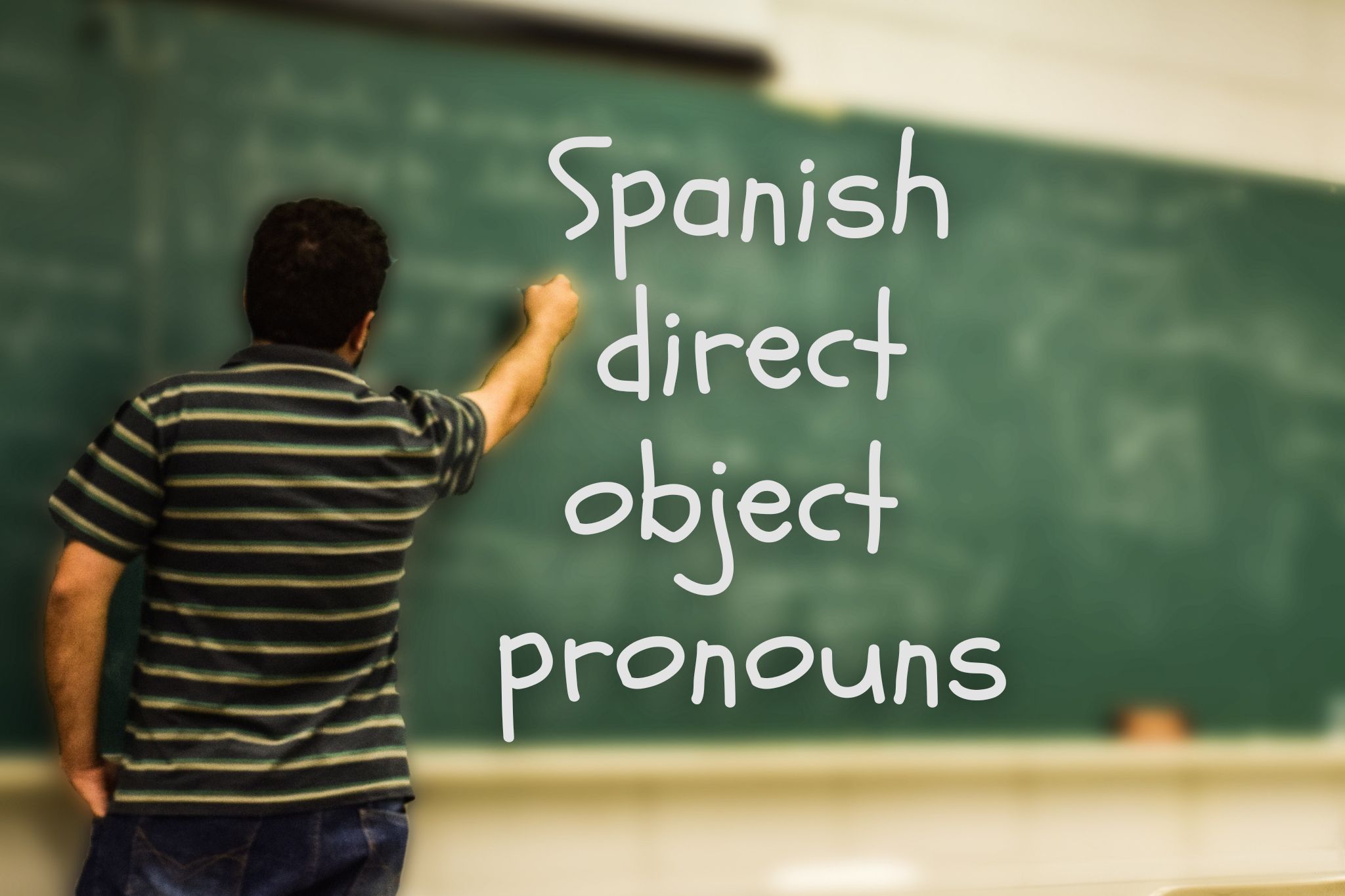Spanish direct object pronouns: Explained for beginners

Get our free email course, Shortcut to Conversational.
Have conversations faster, understand people when they speak fast, and other tested tips to learn faster.
More infoKnowing how to use Spanish direct object pronouns is essential to graduating from basic Spanish to becoming a decent conversational speaker. Let’s dive straight in with the list of direct object pronouns in Spanish:
| Subject pronouns: Spanish | Direct object pronouns: Spanish | Direct object pronouns: English |
| yo | me | me |
| tú | te | you |
| él, ella, usted | lo, la | him, her, it, you |
| nosotros, nosotras | nos | us |
| vosotros, vosotras | os | you |
| ellos, ellas, ustedes | los, las | them, you |
In this post you’ll learn everything you need to know to recognize and use Spanish direct object pronouns correctly. We’ll start off with the basics of what is a direct object, looking at examples in both English and Spanish. Then we’ll get into how we replace direct objects with pronouns.
Once we’re clear on direct objects and their Spanish pronouns, we’ll cover their placement in sentences. We’ll start with simple phrases and move up to sentences with multiple verb forms. We’ll even cover sentence structure in cases where the verb takes both direct and indirect objects, with plenty of examples to demonstrate the various options.
Finally, we’ll wrap up with a summary of all the personal pronouns in Spanish so you can keep the direct object pronouns clear from all the others!
How to identify a direct object in a sentence
In a sentence, something that receives the action of the verb is known as the direct object. This can be any noun, whether a person, an animal, an object, or even a concept. The direct object can even be a multi-word phrase. Let’s see this with a handful of verbs whose direct object in these examples is a car:
I want to borrow a car. You‘re driving that car. My dad lends me his car. We washed the new car. You all pushed the broken-down car. They see our car.
In grammatical terms, all of these verbs are acting as transitive verbs, which means that they take a direct object in order to complete the phrase. To determine the direct object, we can ask the question “to whom?” or “to what?” the verb’s action is being done. If the verb is doing its action on someone or something, this “something” is the direct object.
The direct objects in the simple English sentences above are a car, that car, his car, the new car, the broken-down car, and our car. Now let’s replace each noun phrase of our previous examples with a direct object pronoun:
I want to borrow it. You’re driving it. My dad lends it to me. We washed it. You all pushed it. They see it.
How to identify a direct object in Spanish
In Spanish sentences, how do you identify the direct object noun? Typically, we find it after the action verb, just like in English sentences.
Recognizing the direct object in a Spanish sentence is often easier when the action of the verb is directed at a person or animal (an animate object), as the sentence frequently uses the preposition a to indicate to whom or at whom the action is directed.
- I can’t find my friends. – No encuentro a mis amigas.
- I have to bathe my children. – Tengo que bañar a mis niños.
Even though we don’t need the preposition with inanimate objects in Spanish, the same rules for recognizing the direct object apply that we’ve already seen.
- I don’t see the moon. – No veo la luna.
- You need to do your homework. – Necesitas hacer tu tarea.
In these examples, our direct objects are mis amigas, mis niños, la luna, and tu tarea. Now let’s replace these with Spanish direct object pronouns:
- I cannot find them. – No las encuentro.
- I have to bathe them. – Tengo que bañarlos.
- I don’t see it. – No la veo.
- You need to do it. – Necesitas hacerla.
List of Spanish direct object pronouns
Now that we’ve seen how to find the direct object in Spanish sentences, we’re ready to take a closer look at the Spanish direct object pronouns. Let’s start off by looking at the singular pronouns first, and then the plural ones. We’ll provide an example sentence using every single one.
Remember that pronouns need to reflect the gender and number of nouns they replace. Keep this in mind when addressing people with usted.
Singular
| Subject pronouns: Spanish | Direct object pronouns: Spanish | Direct object pronouns: English |
| yo | me | me |
| tú | te | you |
| usted | lo, la | you |
| él, ella | lo, la | him, her, it |
- She gives me goosebumps. – Ella me pone la piel de gallina.
- Yesterday we saw you in the church. – Ayer te vimos en la iglesia.
- Welcome, sir. We were waiting for you. – Bienvenido, señor. Lo estábamos esperando.
- I respect you a lot, Mrs. Diaz. – La respeto mucho, señora Diaz.
- The teacher needs to call him to talk about the exam. – El profesor necesita llamarlo para hablar sobre el examen.
- My brother can help her tomorrow. – Mi hermano puede ayudarla mañana.
- I can’t find my scarf. I think I lost it. – No puedo encontrar mi bufanda. Creo que la perdí.
Did you notice how the direct object pronouns in the two usted phrases each reflected the gender of the person being addressed? Masculine nouns become lo, while feminine nouns become la. In the previous examples, we used lo for señor, and la for señora.
The same gender rule applies for the pronouns that translate as him, her, and it. In the last example, since una bufanda is feminine, its direct object pronoun must be la.
Plural
| Subject pronouns: Spanish | Direct object pronouns: Spanish | Direct object pronouns: English |
| nosotros, nosotras | nos | us |
| vosotros, vosotras | os | you |
| ustedes | los, las | you |
| ellos, ellas | los, las | them |
- The storm hit us. – La tormenta nos golpeó.
- Ladies and gentlemen, the train will arrive in five minutes. It was a pleasure transporting you. – Damas y caballeros, el tren llegará en cinco minutos. Fue un placer transportarlos.
- Excuse me, ladies. Sorry for bothering you. – Disculpen, señoras. Perdón por molestarlas.
- The boys are leaving. The driver will take them in his car. – Los chicos se van. El conductor los llevará en su carro.
- Do you have the tickets? / Yes, we have them. – ¿Tienen las entradas? / Sí, las tenemos.
- Thank you guys so much for coming to my party. I love you so much, you are the best. – Muchas gracias por venir a mi fiesta, chicos. Os amo mucho, sois los mejores.
- And where are you guys at? I’ve been waiting for you for over an hour! – ¿Y vosotras dónde estáis metidas? ¡Os llevo esperando más de una hora!
Just as we did with the singular pronouns, did you notice how we used los or las as pronouns to reflect the gender of our plural ustedes? In the second example we’re addressing señoras, so the direct object pronoun is las. In Spain, where people use vosotros as the plural you, the pronoun os remains unchanged.
Placing Spanish direct object pronouns in a sentence
Knowing where exactly to place direct object pronouns in a sentence can be tricky for some students. Inserting pronouns in an incorrect position often won’t make any sense – or worse, you’ll end up saying something completely different.
In this section we’ll explain where to place the direct object pronouns in Spanish sentences, depending on the sentence structure.
Direct object pronoun + Conjugated verb
When the pronoun is the direct object of a conjugated verb, we can only place it directly before the verb. This is the most common sentence structure, so you should get the hang of this order with just a bit of practice and exposure. Here’s the structure of our phrase:
[direct object pronoun] + [conjugated verb]
This was the placement shown in most of the example sentences we’ve seen so far in the previous sections. Let’s see a couple more examples:
- I want it, it’s my favorite book. – Lo quiero, es mi libro favorito.
- Here’s our dinner. I prepared it with a lot of love. – Aquí está nuestra cena. La preparé con mucho cariño.
Direct object pronoun + Infinitive verb
Typically, when there is an infinitive verb in the sentence, a conjugated verb precedes it. With this sentence structure, you’ll need to be careful to avoid confusing it with the previous scenario. In these sentences, it’s the infinitive verb’s action that’s taking the direct object.
In this case, we have two options when it comes to placing the pronoun. The most common is to attach the direct object pronoun directly to the end of the infinitive verb. This is the structure we saw in several of our example sentences in the previous section. In this case, here’s the structure:
[conjugated verb] + [infinitive verb][direct object pronoun]
- Have you seen this movie? / Not yet. I want to see it! – ¿Has visto esta película? / Todavía no. ¡Quiero verla!
- I don’t like this watch anymore. I am going to sell it. – Ya no me gusta este reloj. Voy a venderlo.
The other sentence structure is similar to the one we saw previously, since we place the direct object pronoun directly before the conjugated verb. Native speakers tend to use this order less, but it’s still correct. Here’s this structure:
[direct object pronoun] + [conjugated verb] + [infinitive verb]
- Have you seen this movie? / Not yet. I want to see it! – ¿Has visto esta película? / Todavía no. ¡La quiero ver!
- I don’t like this watch anymore. I am going to sell it. – Ya no me gusta este reloj. Lo voy a vender.
Let’s just review these two options, both of which have the same English translation:
- I want to see it! – ¡Quiero verla! – ¡La quiero ver!
- I am going to sell it. – Voy a venderlo. – Lo voy a vender.
Direct object pronoun + Present progressive tense
The present progressive tense in Spanish is used when something is happening at the moment of speaking. This tense is built with a conjugated form of the Spanish verb estar followed by the gerund of the action verb, just as English uses the verb to be followed by the -ing form of the action verb.
In this situation with the progressive verb form, the direct object pronoun can be placed in the same two positions as we saw in the previous scenario with the infinitive form: either attached to the end of the gerund, or before the conjugated verb:
[conjugated form of estar] + [gerund][direct object pronoun]
[direct object pronoun] + [conjugated form of estar] + [gerund]
Let’s see a couple of examples where the direct object pronoun is attached to the end of the gerund. This is the word order used most by native speakers:
- Did you do your homework? / I’m doing it now! – ¿Hiciste tu tarea? / ¡Estoy haciéndola ahora!
- The chairs were dirty, so we are cleaning them. – Las sillas estaban sucias, así que estamos limpiándolas.
And now let’s see these same examples with the direct object pronoun placed before the conjugated form of estar:
- Did you do your homework? / I’m doing it now! – ¿Hiciste tu tarea? / ¡La estoy haciendo ahora!
- The chairs were dirty, so we are cleaning them. – Las sillas estaban sucias, así que las estamos limpiando.
Now let’s review the two forms of the two example phrases and compare their differences:
- I’m doing it now! – ¡Estoy haciéndola ahora! – ¡La estoy haciendo ahora!
- We are cleaning them. – Estamos limpiándolas. – Las estamos limpiando.
Did you notice the extra accent on the gerunds where the direct object pronouns are attached to the progressive verb? Adding this accent is another quirky rule when using this sentence structure in Spanish!
Direct object pronoun + Imperative mood
When we give commands using the imperative form, we must attach the direct object pronoun to the end of our imperative conjugation. As we saw just above with gerunds, this construction also triggers an extra accent getting added to the conjugated form of the verb.
[Imperative conjugation][direct object pronoun]
Here are a couple of examples:
- Help him with his homework. – Ayúdalo con su tarea.
- We need food. Buy it at the mall. – Necesitamos comida. Cómprala en el centro comercial.
Direct object pronoun + Negative form
Once you’ve gotten the hang of all the affirmative sentence structure options we’ve covered so far, putting them in the negative is easy. We just place no before any construction we use in the affirmative, and it becomes negative. Simple!
Let’s see some negative forms of the affirmative example sentences from the preceding sections. Where there are two options, we include both:
- I don’t want it. – No lo quiero.
- I am not going to sell it. – No voy a venderlo. – No lo voy a vender.
- We are not cleaning them. – No estamos limpiándolas. – No las estamos limpiando.
- Don’t buy it at the mall. – No la compre en el centro comercial.
Did you notice the difference in the last example, where we used a different form of the verb for the negative imperative? This change is unrelated to the direct object pronouns, but is rather a rule on how to use the command form in Spanish. Check out our dedicated post on the Spanish imperative mood for a full explanation, while to get a handle on the conjugation we use for negative commands we’ll refer you to our post on present subjunctive Spanish.
Direct object pronoun + Indirect object pronoun
So far in this post, we’ve avoided indirect object pronouns. To be honest, things can get a bit confusing when we start mixing both types of Spanish object pronouns, since many of them use the exact same words (just like in English)! We’ll nonetheless touch on them here so you know the right sentence order, while we include the full list of indirect object pronouns in our summary table in the next section. For a full explanation, please check out our guide to mastering indirect object pronouns in Spanish.
Word order is actually very straightforward in sentences whose action verbs have both direct and indirect object pronouns: the indirect object pronoun is always placed before the direct object pronoun. To sum up, this is always the order:
[indirect object pronoun] + [direct object pronoun]
In any of the scenarios where both types of object pronouns are placed before the Spanish verbs, the two are kept as separate words. In any of the scenarios where they’re attached to the end of the verb, the two are attached together. The sentence structure isn’t otherwise modified from all the scenarios we saw above.
Let’s see a few examples. We’ll continue to just highlight the direct objects:
- See these flowers? My girlfriend gave me them. – ¿Ves estas flores? Mi novia me las regaló.
- Did you receive the gifts? We sent them to you last month. – ¿Recibiste los regalos? Te los enviamos el mes pasado.
- Did you receive the confirmation, or do I need to send it to you again? – ¿Recibiste la confirmación o necesito enviártela de nuevo? – ¿Recibiste la confirmación o te la necesito enviar de nuevo?
- Would you like to have salad for dinner? I’m preparing it for you now. – ¿Quieres cenar ensalada? Estoy preparándotela ahora. – ¿Quieres cenar ensalada? Te la estoy preparando ahora.
- Did you take my stuffed animal? Give it back to me now! – ¿Te llevaste mi animal de peluche? ¡Devuélvemelo ahora!
Through all these examples where we see both types of Spanish object pronouns, the word order should be clear: always the indirect then direct object pronouns.
There’s one additional rule we should mention here, though it doesn’t change the word order at all. Instead, it’s a spelling change whenever both of the object pronouns start with the letter l: in these instances, the indirect object pronoun always becomes se, regardless of whether it’s replacing the singular le or the plural les. Let’s see a few examples where the indirect pronouns become this form of se in Spanish:
- See those flowers my boyfriend has? I gave them to him. – ¿Ves esas flores que tiene mi novio? Yo se las di.
- They didn’t receive the confirmation. We need to send it to them again. – No recibieron la confirmación. Tenemos que enviársela de nuevo. – No recibieron la confirmación. Se la tenemos que enviar de nuevo.
- Did you take your sister’s stuffed animal? Give it back to her now! – ¿Te llevaste el peluche de tu hermana? ¡Devuélveselo ahora!
All the Spanish personal pronouns
We’ll end our lesson today with the full list of the personal pronouns in the Spanish language. You probably already know the Spanish subject pronouns quite well, and by this point in our lesson you should also be comfortable enough with the direct object pronouns. We include the indirect object pronouns and the reflexive pronouns here so you can see where they’re similar and where they differ.
| Subject pronouns, Spanish | Direct object pronouns, Spanish | Indirect object pronouns, Spanish | Reflexive pronouns, Spanish |
| yo | me | me | me |
| tú | te | te | te |
| él, ella, usted | lo, la | le* | se |
| nosotros, nosotras | nos | nos | nos |
| vosotros, vosotras | os | os | os |
| ellos, ellas, ustedes | los, las | les* | se |
*Remember, as we saw in the last section, that the third-person indirect object pronouns are replaced with the se form when they’re placed directly before any third-person direct object pronouns.
Spanish direct object pronouns: Conclusion
In today’s post we’ve covered everything you need to know to master direct object pronouns in Spanish.
We began with a general review on what are direct objects, highlighting their role in receiving the action of the verb. We quickly moved on to learning the different direct object pronouns themselves, broken down by singular and plural.
Then came the lessons on sentence structure, from the straightforward word order of simple phrases, to the different word-order options in sentences with multiple verb forms. In cases where we attach the direct object pronouns to the end of certain verb forms, we saw the special spelling rules where we add an accent to their original forms. We even covered the rules for phrases where the action verbs have both indirect and direct object pronouns, including the rule where we sometimes replace the third-person indirect object pronoun with se.
We rounded out this lesson with a full list of the personal pronouns in Spanish, allowing a comparison between subject, direct object, indirect object, and reflexive pronouns.
If you found this lesson useful, we recommend bookmarking it as a quick point of reference. Even better, why not share it with other Spanish learners who could benefit from our explanations of Spanish direct object pronouns? Thanks for reading!



